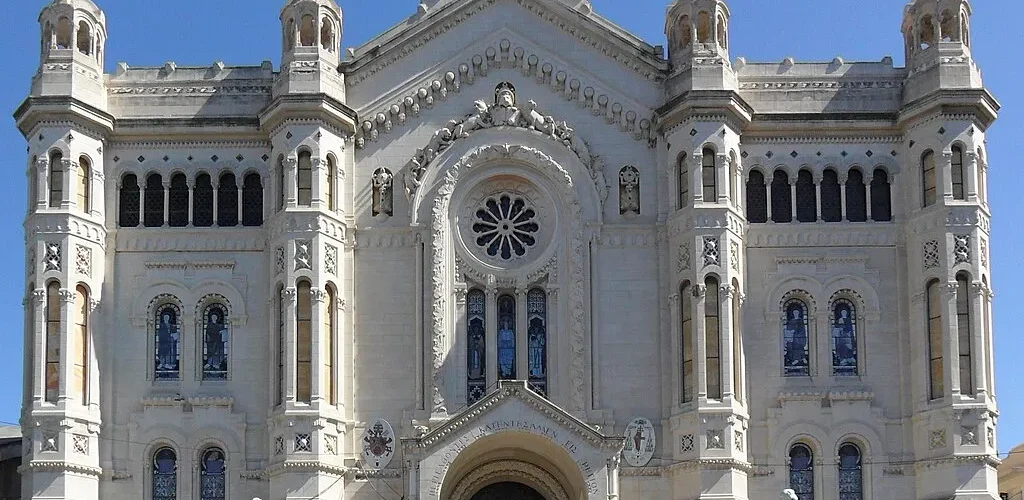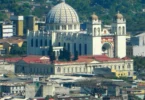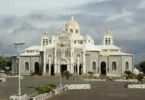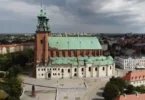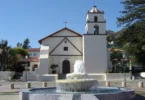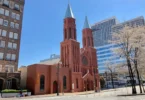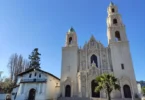Introduction
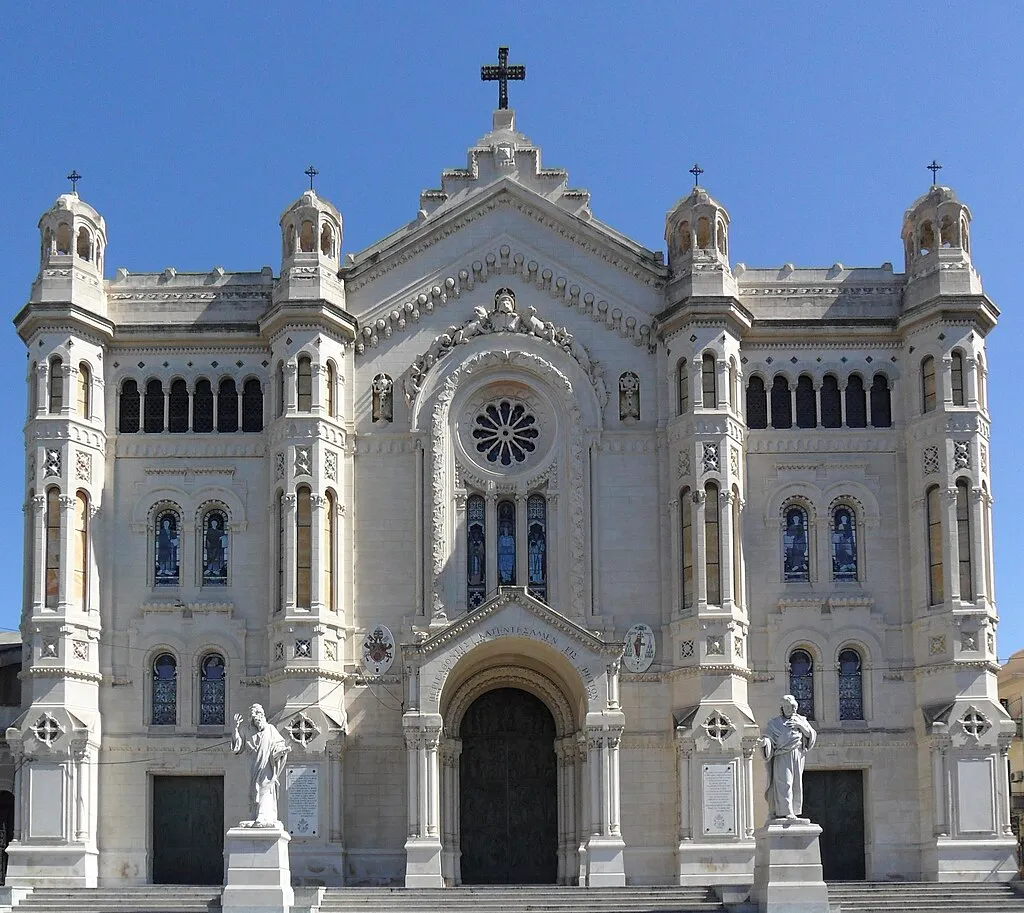
The Metropolitan Cathedral Basilica of Maria Santissima Assunta in Cielo, commonly known as Reggio Calabria Cathedral, is the largest religious structure in Calabria, Italy. Located in the heart of the historic city of Reggio Calabria, this majestic cathedral serves as the principal church of the Archdiocese of Reggio Calabria-Bova. Dedicated to the Assumption of the Virgin Mary, it stands prominently in Piazza del Duomo, the city’s central square, where its grand façade captivates visitors and locals alike. Originally, the cathedral was the archiepiscopal seat of the Archdiocese of Reggio Calabria, a role it retained until the formation of the Archdiocese of Reggio Calabria-Bova. The cathedral’s significance, both religious and architectural, is heightened by its rich history, as it has been the site of worship and devotion for centuries.
In 1908, a devastating earthquake struck the region, severely damaging the cathedral and prompting the need for extensive reconstruction. The rebuilding efforts, which began shortly after the earthquake, resulted in the cathedral being reconstructed in an eclectic style, blending Romanesque and Gothic elements. The original design was created by Engineer P. Carmelo Umberto Angiolini, and later modified by Engineer Mariano Francesconi to adapt to the needs of the new structure. The newly rebuilt cathedral was consecrated in 1928, giving it a fresh identity while maintaining its spiritual and cultural significance for the people of Reggio Calabria. Today, the cathedral stands as a symbol of resilience, faith, and artistic achievement, representing both the deep-rooted traditions of the region and the modern renewal following the catastrophic earthquake.
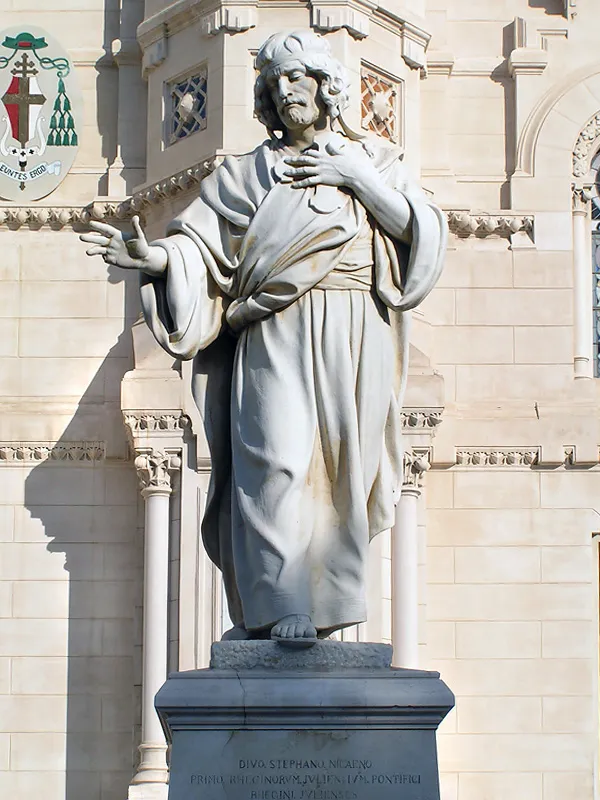
Origins of the Cathedral and Early Development
The origins of the Reggio Calabria Cathedral, also known as the Metropolitan Cathedral Basilica of Maria Santissima Assunta in Cielo, date back to the early centuries of the second millennium. Following the Norman invasion of Southern Italy, the city of Reggio underwent a significant transformation, particularly with the introduction of Latin Christianity, which gradually replaced the local Greek-Byzantine practices. In 1061, Robert Guiscard and the Normans arrived in Reggio, conquering the city and establishing the Duchy of Calabria. They displaced the Byzantine influence and commissioned the construction of a new cathedral that would align with the Roman Catholic Church, to which the Normans were devoted. The original cathedral, referred to as “La Cattolica,” was entrusted to the Greek population of the city, while the Normans set about constructing a new church in the Roman Catholic tradition. Over time, this cathedral grew in prominence and eventually became a focal point for worship in the region.
Gothic-Norman Architecture and Development
By the 12th century, the Reggio Calabria Cathedral had likely adopted a Gothic-Norman style, featuring a significant structure with five naves. Scholars note that the cathedral’s layout and dimensions were strikingly similar to those of the Cathedral of Cefalù in Sicily. This building reflected the architectural influences of the time and showcased the growing importance of the cathedral in the region. Documented records from 1453 and 1477 indicate that during this period, Archbishop Antonio De Ricci added a bell tower to the cathedral. The bell tower was a key addition, as the cathedral had previously lacked such a feature.
Turkish Raids and Restoration Efforts
Throughout the 16th century, the cathedral, like many buildings in Reggio, faced destruction due to Turkish raids. The city was attacked twice by Turkish forces, first in 1574 and again in 1594, both times resulting in fires that caused significant damage. The cathedral was rebuilt following each attack. In 1580, after the first fire, it was reconsecrated by Archbishop Gaspare Ricciullo del Fosso. Further restoration efforts were made after the second fire, including those by Archbishop Annibale D’Afflitto in 1599 and Archbishop Gaspare Creales in 1665. In 1682, Archbishop Ybañez made substantial improvements to the cathedral, restoring it both inside and out. A commemorative plaque, placed within the cathedral, detailed the privileges of the Reggio archbishopric and highlighted the cathedral’s historical significance.
Baroque and Neoclassical Periods
By the early 18th century, the cathedral underwent a major transformation when Monsignor Polou had the structure rebuilt in the late Baroque style. The new design featured a Latin cross layout with three naves. The building was located near the modern-day Via Castello and extended towards Corso Garibaldi. However, the cathedral was severely damaged by the earthquake of 1783, which affected much of the city. After the earthquake, the engineer Giovan Battista Mori led further restoration efforts, with the church reconsecrated by Monsignor Capobianco. Subsequent restorations continued throughout the 19th century, with ongoing embellishments, including by Monsignor Cernicola and Monsignor Converti. The structure’s façade bore an inscription from the Acts of the Apostles that read: “CIRCUMLECENTES DEVENIMUS RHEGIUM,” translating to “Coasting, we reached Reggio” (Acts 28:13), reflecting the historical connection of St. Paul’s visit to the city.
The Earthquake of 1908 and the New Cathedral
The most significant transformation of the cathedral came after the devastating earthquake of 1908, which caused substantial destruction in Reggio Calabria, including the cathedral. In response, the archbishop Rinaldo Rousset decided to rebuild the cathedral entirely. The task was entrusted to Carmelite Father Carmelo Umberto Angiolini, who, in 1917, designed the new cathedral in a neo-Romanesque style. This design combined Romanesque and Gothic elements, reflecting the eclectic trends of the period. The use of modern materials and anti-seismic measures ensured that the new structure would withstand future disasters. The rebuilding was completed by 1928, and the cathedral was consecrated on September 2, 1928, by Archbishop Carmelo Pujia. This marked the beginning of a new era for the cathedral, which stood as a symbol of resilience and faith for the people of Reggio Calabria.
Elevation to Minor Basilica
In recognition of its historical, religious, and architectural significance, the cathedral was elevated to the status of a minor basilica by a papal bull on June 21, 1978. The cathedral’s importance was highlighted in the papal declaration, which emphasized its historical connection to St. Paul the Apostle, who had visited Reggio Calabria, and its prominent role in the religious life of the region. The bull stated, “Among the many titles of honor, religious piety, and faith, for which the Church of Reggio has distinguished itself, one of the most ancient and venerable, in a rightly particular manner, it boasts both for the coming to Reggio of St. Paul the Apostle and for its Cathedral Church. This for its breadth and the splendor of the art, as well as for the memories of the saints kept there, and for the multitudes of faithful who gather there, stands out in fact and truly as the first among all the churches of Calabria.” Today, the Reggio Calabria Cathedral stands as a vital cultural, religious, and historical monument for the city and the region, representing the resilience and continuity of faith across the centuries.
Architecture of Cathedral Basilica of the Assumption of Mary, Reggio di Calabria, Italy
Architectural Style : Romanesque Revival architecture.
Architectural Style and Design
The Cathedral of Reggio Calabria exhibits an eclectic-liberty architectural style, a hallmark of the city’s reconstruction period following the 1908 earthquake. This style blends medieval Romanesque and Gothic elements, harmoniously combining aspects from both traditions to create a unique architectural expression. The design of the cathedral reflects the eclectic cultural movement of the early 20th century, which sought to reinterpret historical styles with a modern twist. The architecture exudes solemnity and grandeur, ensuring that the building is both an artistic masterpiece and a functional house of worship.
The Main Facade
The main façade of the cathedral is divided into three parts, with four octagonal pierced towers, each surmounted by crosses. This division creates a distinct vertical rhythm that is both monumental and refined. Central to the façade is a three-light window beneath a prominent rose window, which is framed with a decorative motif of floral designs. The rose window is an exceptional example of the architectural finesse, serving as a focal point that draws attention while symbolizing divine light. At the base of the steps leading to the cathedral, two grand statues stand guard. These statues represent Saint Paul, who is said to have converted the people of Reggio to Christianity, and Saint Stephen of Nicea, the city’s first bishop. These statues were sculpted in 1928 by Francesco Jerace and placed in front of the church in 1934. Jerace, a renowned sculptor, is also credited with creating the monumental pulpit inside the cathedral, further contributing to the church’s artistic legacy.
Bronze Portals and Commemorative Inscriptions
The bronze portals of the Cathedral of Reggio Calabria are significant artistic and religious features of the building, each symbolizing key aspects of the church’s devotion and history. The central portal, designed by Luigi Venturini, was unveiled during the XXI National Eucharistic Congress in 1988 and is dedicated to the Madonna. It depicts various scenes from her life, emphasizing her importance in the Catholic faith. The left entrance door, crafted by Biagio Poidomani, portrays Reggio’s devotion to the Madonna della Consolazione, a central figure in the local religious tradition. The right entrance door, designed by Nunzio Bibbò, honors Saint Paul, illustrating key moments from his apostolic missions, which are integral to the church’s origins in Reggio. Above the entrance, the Greek inscription from the Acts of the Apostles (28:13) reads «ΠΕΡΙΕΛΘΟΝΤΕΣ ΚΑΤΗΝΤΗΣΑΜΕΝ ΕΙΣ ΡΗΓΙΟΝ», meaning “Sailing along, we reached Reggio,” highlighting the historic connection between the cathedral and early Christianity in the region. Additionally, commemorative plaques on either side of the entrance mark significant events, such as the visit of Pope John Paul II in 1984 and his speech during the National Eucharistic Congress in 1988, further linking the cathedral to the broader Christian community.
Bell Tower
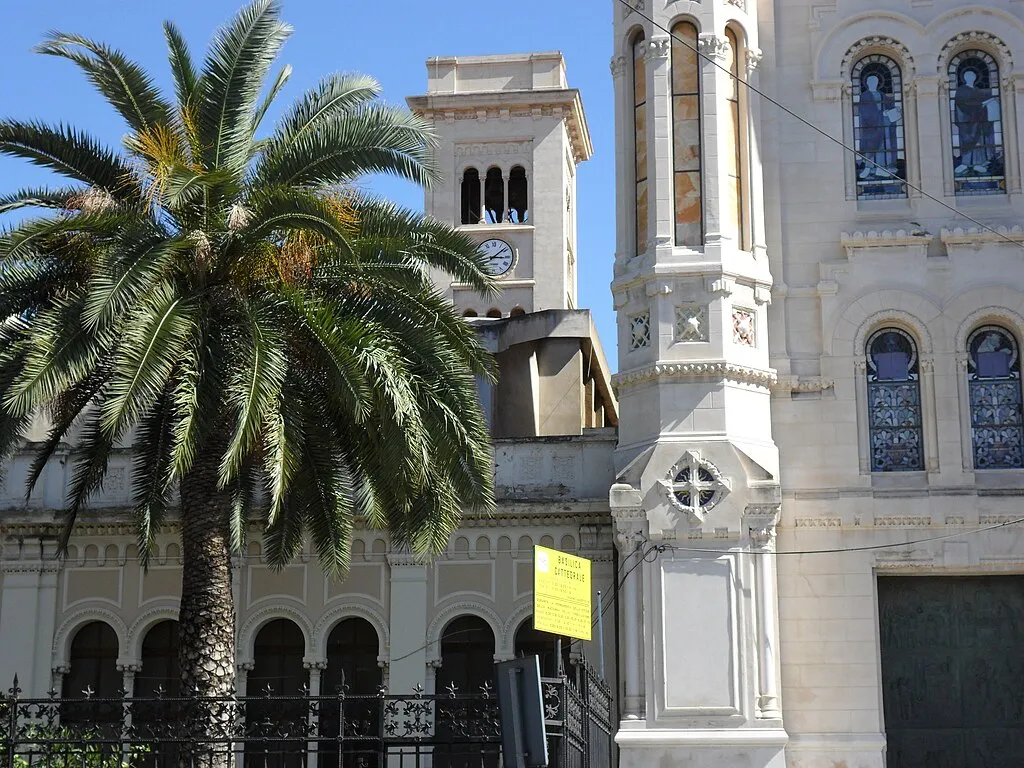
The bell tower of the cathedral is an integral feature of the church’s architecture, standing at a height of 28.15 meters (43.67 meters above sea level). Completed on September 30, 1931, the bell tower mirrors the style of the cathedral itself and replaced the earlier tower destroyed by the 1908 earthquake. A commemorative plaque near the base of the bell tower acknowledges its historical significance. It recalls the 1453 construction of the original tower by Archbishop De Ricci and the 1841 rebuilding undertaken by Archbishop Pietro De Benedetto. The plaque also notes the architectural challenges faced when constructing the new tower, which was positioned at a lower elevation due to unstable ground conditions.
The bell tower houses several bells:
- The Bell of Conciliation, located in the first bell tower, was installed in memory of the Regional Eucharistic Congress held in 1926 and bears an inscription commemorating the event.
- In the upper section of the bell tower, three important bells are housed:
- The Bell of Congress, also known as the Bell of Consolation.
- The Chapter Bell, referred to as the big bell.
- The Campanone, the largest bell, recast in 1750 after the earlier bell was damaged in the 1750 earthquake. The Campanone bears the bishop’s coat of arms and several sacred figures, including the Crucifix, the Virgin Assumed into Heaven, and Saint Joseph. The bell’s inscription calls on the faithful to gather for worship and celebrates the Jubilee Year of 1750.
The Bell of Consolation, recast in 1926, honors the dedication of the new cathedral and the first Calabrese Eucharistic Congress of 1928. This bell features inscriptions that highlight the role of the Madonna and Saint Therese of the Child Jesus, invoking their intercession for the faithful.
Illuminated Glass Windows
The cathedral’s windows are made of illuminated glass, which serve both aesthetic and symbolic purposes. The windows fill the interior with light, creating a spiritual atmosphere that enhances the religious experience. The glasswork, while simple in design, reflects the cathedral’s modern architectural elements, harmonizing with the other decorative features.
Internal Architecture and Artistic Features of the Cathedral of Reggio Calabria

Architectural Layout and Design
The interior of the Cathedral of Reggio Calabria follows a Romanesque style enriched with classical influences. The cathedral has a basilica plan, with a central nave flanked by two side naves, all separated by rows of columns. These columns, which are bundled, support the uncovered trusses that hold up the roof. The design includes cross vaults at each intersection of beams. A unique feature of the cathedral’s ceiling are approximately two hundred swastikas painted on the trusses. Contrary to any association with Nazism, these swastikas were painted in 1928 as symbols of the sun and light, referencing the prophecy in the Song of Zechariah (Luke 1:78-79), which speaks of the dawn from on high visiting and bringing light to those sitting in darkness. The cathedral spans a length of 93 meters and has a width of 26 meters, making it the largest religious structure in the region. Its interior design is organized around three naves, each separated by rows of columns and intersected by three transepts. The space ends in a polygonal apse, creating a striking, expansive interior.
Central Nave and Artistic Significance
The central nave is distinguished by its double rows of columns, which separate it from the two side naves. These columns are made of marble with bases of Trani stone. Along the side naves, there are eight chapels, each housing significant works of art and notable historical relics. The right nave contains tombs of seventeenth-century bishops as well as more recent tombs for bishops from the twentieth century such as Aurelio Sorrentino and Giovanni Ferro. The latter is interred in the second chapel on the right, and his tomb monument was crafted by the artist Michele Di Raco. At the far end of the right nave is a burnt column trunk, encased in glass, which is traditionally believed to be the column of the Miracle of Saint Paul. This column is associated with the legend of Saint Paul, who is said to have performed miracles in the region. In the central apse, the high altar is a Romanesque-style creation by Concesso Barca. Adjacent to it is a marble archiepiscopal chair from the 19th century, created by Alessandro Monteleone. The altar is adorned with a bronze bas-relief designed by Antonio Berti.
Left Nave and Artistic Treasures
The left nave contains a number of chapels, one of which is the Chapel of the Blessed Sacrament—the most significant Baroque monument in the city. It was originally constructed in 1539 as the Chapel of the Holy Trinity by Archbishop Agostino Gonzaga, but later transformed by the Congregation of the Blessed Sacrament in 1548. This chapel stands as a major national monument in the diocese. The chapel underwent several restorations over the years, particularly in the 17th century under the guidance of Archbishop D’Afflitto and Monsignor Polou, whose work on the chapel was interrupted in 1642. The final restoration was completed by Placido Brandamonte, a master stonemason, in 1655. Though the chapel was damaged in the 1783 and 1908 earthquakes, it was carefully preserved during the reconstruction of the cathedral.
In the 20th century, the chapel endured further damage during the World War II air raids but was ultimately restored under Archbishop Ferro, who also commissioned Nunzio Bava, a Reggio Calabria painter, to create several works for the chapel. Bava’s paintings depict scenes from both the Old and New Testaments, including the Prophet Elijah being awakened by an angel, Moses striking the rock to bring forth water, and the Multiplication of the Loaves and Fishes. The chapel is surrounded by polychrome marble inlays and Florentine mosaic inlays, with images of flowers and animals created using soft-colored marbles and Venetian enamels. Statues of the Apostles Peter and Paul, the Evangelists, and the Eucharistic Doctors Saint Thomas and Saint Bonaventura are set in niches, each crafted from white marble by the artists Francesco Jerace and Concesso Barca. The main altar of the chapel is supported by four columns of black porphyry with yellow veins, and the altar is crowned by a painting by Domenico Marolì, created in 1665, which depicts the Sacrifice of Melchizedek. Above the altar, a small stained-glass window displays Eucharistic symbols.
Pipe Organ and Music
The cathedral’s first pipe organ was built in 1930 by the Balbiani company. This instrument, with two keyboards and pedals, was later moved to the Church of San Giorgio al Corso in 1968. It was replaced by a larger organ constructed by the Fratelli Ruffatti company, which had three keyboards and pedals, totaling 3252 pipes. The organ was subsequently expanded and restored between 2001 and 2008 by the Michelotto company, with an addition of a fourth keyboard and a new console. The current organ features a total of 4805 pipes and 13 tubular bells, distributed across 73 registers, including 51 real registers and 22 extension registers. The organ’s console, which is an independent mobile unit, is located in the transept and features four 61-note keyboards and a 32-note pedal board.
Diocesan Museum
Adjacent to the Cathedral is the Diocesan Museum of Reggio Calabria, which houses an array of sacred objects and church furnishings. Among its treasures are a 14th-century silver and enameled staff, a gold chalice and pyx donated by Pius XI in 1928, and a golden monstrance created by Francesco Jerace. These items are significant both for their artistic value and their historical importance in the diocese’s religious practices.
Feast Day
Feast Day : 15th August
The Feast Day of the Cathedral Basilica of the Assumption of Mary in Reggio di Calabria, Italy is celebrated on August 15th each year. This date marks the Feast of the Assumption of the Blessed Virgin Mary, a major feast in the Christian liturgical calendar, commemorating the belief that Mary was taken bodily into heaven at the end of her earthly life. The feast is particularly significant in Catholic tradition and is celebrated with special liturgies and events in many churches, including the Cathedral Basilica of the Assumption of Mary in Reggio di Calabria.
Church Mass Timing
Monday : 7:30 AM , 9:00 AM , 6:00 PM.
Tuesday : 7:30 AM , 9:00 AM , 6:00 PM.
Wednesday : 7:30 AM , 9:00 AM , 6:00 PM.
Thursday : 7:30 AM , 9:00 AM , 6:00 PM.
Friday : 7:30 AM , 9:00 AM , 6:00 PM.
Saturday : 7:30 AM , 9:00 AM , 6:00 PM
Sunday : 7:30 AM , 9:30 AM , 11:00 AM , 6:00 PM.
Church Opening Time:
Monday : 7:00 am – 12:00 pm., 4:00 pm – 8:00 pm.
Tuesday : 7:00 am – 12:00 pm., 4:00 pm – 8:00 pm.
Wednesday : 7:00 am – 12:00 pm., 4:00 pm – 8:00 pm.
Thursday : 7:00 am – 12:00 pm., 4:00 pm – 8:00 pm.
Friday : 7:00 am – 12:00 pm., 4:00 pm – 8:00 pm.
Saturday : 7:00 am – 12:00 pm., 4:00 pm – 8:00 pm.
Sunday : 7:00 am – 12:00 pm., 4:00 pm – 8:00 pm.
Contact Info
Address :
Cathedral Basilica of the Assumption of Mary
Via Tommaso Campanella, 46, 89127 Reggio di Calabria RC, Italy.
Phone : +39096528685
Accommodations
Connectivities
Airway
Cathedral Basilica of the Assumption of Mary, Reggio di Calabria, Italy, to Reggio Calabria Airport (REG) Via Ravagnese, distance between 9 min (6.6 km) via E90.
Railway
Cathedral Basilica of the Assumption of Mary, Reggio di Calabria, Italy, to Reggio Di Calabria Centrale Via Barlaam, distance between 6 min (1.5 km) via Via Argine Sinistro Calopinace.

